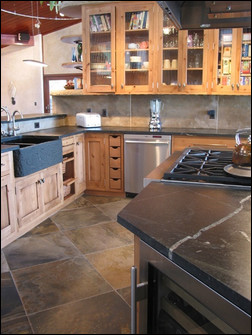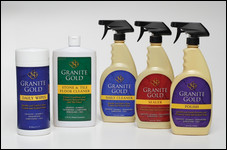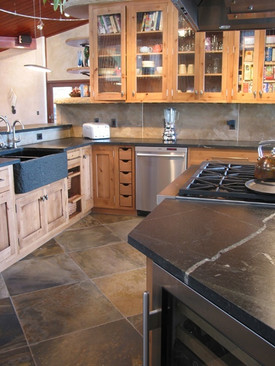Many homeowners opt for natural stone countertops, flooring or pavers as a way to add elegance to their homes. What they might not bargain for, however, is the unique maintenance stone requires to keep it looking new.
 Slate Floors and Countertops Stone floors and countertops, like these made of natural slate, can be low-maintenance surfaces. Photo courtesy of El Dorado Stone. |
“Homeowners are always asking how to care for their stone surfaces,” says Lenny Sciarrino, a San Diego, Calif.-based stone fabricator with more than 15 years experience in the business and a keen interest in stone maintenance. Stone countertops are one of the top requested features for home remodels, and Sciarrino says 43 percent of countertops in the United States will be made of stone by 2009. The increased popularity has fueled demand for products that make cleaning stone a snap. For this reason, Sciarrino teamed up with his cousin and fellow stone contractor, Lenny Pellegrino, in 2003 to create Granite Gold, a line of stone maintenance and cleaning products. The goal, he says, is to help consumers preserve their investment by informing them about the proper ways to care for natural stone.
When to Seal Stone
If you’re installing stone as a floor or countertop surface, many contractors will recommend that you seal the stone to maintain its original color and protect it from dirt, grease and stains. “Stones have varying degrees of stain resistance, and you can test which stones need a sealer by placing a few drops of water on the unsealed surface and see if it soaks in,” Sciarrino says. Wait about 20 minutes, and if the water soaks in instead of beading up, be sure to seal it with an impregnating sealer. He recommends using a food-safe penetrating sealer on countertops.
According to the Marble Institute of America, granite has built-in stain resistance and doesn’t necessarily need to be sealed, but sealing these surfaces can help boost
 Specialized stone care products make cleaning stone countertops and flooring a breeze. Photo courtesy of Granite Gold. |
the resistance and buy time when serious spills occur. Travertine, in particular, benefits from a good sealer because even the smallest amount of acidic foods, such as lemon juice, orange juice or vinegar, will etch the surface and leave a dull mark. Slate, in comparison, is naturally more stain-resistant, yet using a sealer will help protect it from tougher stains like soy sauce and red wine. Sealers also help to intensify the colors and natural beauty of slate. Aqua Mix, Cerama Seal and Miracle Sealants are a few companies that make high-quality sealers for stone floors and countertops. Sealers often need to be reapplied every year or two to keep the stone protected, so read the label and talk to your stone care professional.
Stone Cleaning Tips
Once the stone is sealed, the type of stone you have will determine the care and maintenance program you need. Natural stone can be classified into two categories, according to the Marble Institute of America. Siliceous stone, which is composed of silica or quartz-like elements, is very durable and easy-to-clean with a mild acidic solution. Examples of siliceous stone include granite, slate, sandstone, quartzite, brownstone and bluestone. Calcareous stone, made primarily of calcium carbonate, is sensitive to acidic cleaning products. These stones include marble, limestone, travertine and onyx.
“A lot of the common cleaners you find in grocery stores clean well, but they act like liquid sandpaper on your stone surfaces,” says Rod Sigman, technical services manager for Aqua Mix, a stone care product manufacturer in Corona, Calif. Vinegar-based solutions like window cleaners and abrasive cleaners are
 Use a soft cloth and a neutral cleanser to maintain granite countertops. Photo courtesy of Granite Gold. |
no-nos because they can dull your stone finish. “The solvents in Windex can have a hazing effect over time and can break down the sealers on your stone,” Sigman adds.
The safest way to clean any stone countertop is with a pH-balanced cleaner and a soft cloth. Many companies, like Simple Green and Granite Gold, provide stone-safe cleaners that are biodegradable, food-safe and streak-free. Some products are also available in convenient wipes. A fluid stone polish can also help increase the shine on countertops if used occasionally.
Stone floors demand a slightly more labor-intensive approach to cleaning. They require frequent sweeping or dust mopping with a non-treated, dry dust mop. “Abrasive sand and dirt do the most damage to natural stone floors, so you want to do what you can to keep the floor clean,” Sciarrino says. You can cut down on the dirt being tracked into the house by putting mats inside and outside your entrances and encouraging family members to take off their shoes before walking across stone floors. Vacuuming can help pick up dust, but be sure that the metal or plastic attachments won’t scratch your stone surface.
For polished stone, you can damp mop by using a diluted solution of a pH-neutral cleaner designed for stone. Mild dishwashing liquid and warm water can work in a pinch, but using too much soap can leave a film or cause streaks. Textured stone floors clean best by using a soft-bristle brush attached to a long-handled pole that will help pick dirt out of crevices and grout joints. In addition, appliances such as the Hoover Floor Mate can also make cleaning a snap because dirty water gets sucked up automatically, Sigman notes.
It’s important to blot up the liquid spills immediately. If you have trouble removing an oil-based stain (salad dressing, oil and butter are common culprits) from your countertop or flooring, you may be able to remove the stain by using a poultice, which is a homemade paste that helps extract the stain from the stone. (See sidebar for poultice how-to). If all else fails, call a professional for advice.
Stone in the Bath
Water, soaps and cosmetics can harm stone surfaces over time, but there are a few easy tricks that will keep your bathroom counters and floors sparkling like new. Upon installation, apply a penetrating sealer to stone vanity top surfaces, backsplashes, floors and shower surrounds to protect it from soaps, colorful makeup products and oily lotions that can spot or discolor stone. Some sealers need to be reapplied every couple of years to maintain their effectiveness, so check the label or discuss with your stone installer. Marble vanity tops should be treated with a non-yellowing marble wax to help reduce water spotting.
 |
||||
|
||||
To clean, use a damp rag to wipe up spills as soon as they happen in an effort to keep any bath products from setting into the stone. There are plenty of pH-neutral sprays, wipes and eco-friendly cleaners on the market that are specially formulated for granite, travertine, slate and marble surfaces, according to Jennifer Manocchio, spokesperson for Weiman Products, a maker of specialty stone cleaners in Gurnee, Ill. In the shower, you can remove soap scum from stone walls and floors by using a non-acidic soap scum remover, such as one by Weiman Products, or a homemade solution of ammonia and water (1/2 cup ammonia to one gallon of water) washed on with a soft cloth or sponge. The repeated use of ammonia, however, may dull the surface of the stone over time and could prompt a bit of polishing to rejuvenate the surface.
Cleaning Exterior Stone
Outside, stone is exposed to natural elements and traffic. Stone pavers can be a worry-free surface if you spend a bit of time to seal them with a heavy-duty outdoor stone sealer. Regular sweeping will keep them clean, but if a deeper scouring is needed, just scrub with a mild detergent and a bristle brush. Sometimes mold, moss or mildew builds up on exterior walls clad in stone, on stone pavers or near water features accented with stone. To wash away these organic materials, simply scrub them with a mild bleach solution and a bristle brush. Follow up with some fresh water.
Although stone can demand a bit more maintenance than other household surfaces, keeping stone clean and sealed can ensure years of beauty and durability.
Credit: Renovate Your World




























